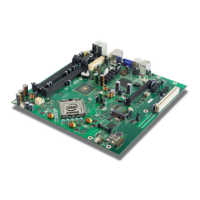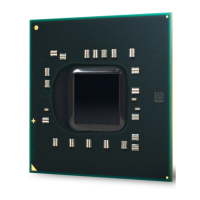
Do you have a question about the Intel E6700 - Core 2 Duo Dual-Core Processor and is the answer not in the manual?
| Processor Number | E6700 |
|---|---|
| Number of Cores | 2 |
| Number of Threads | 2 |
| Base Frequency | 2.66 GHz |
| Cache | 4 MB L2 Cache |
| Bus Speed | 1066 MHz |
| TDP | 65 W |
| Socket | LGA 775 |
| Lithography | 65 nm |
| Instruction Set | 64-bit |
| Virtualization Technology | VT-x |
| Memory Types | DDR2 |
| Release Date | July 2006 |
Describes the purpose and scope of the thermal design guidelines.
Lists supporting documents for understanding material and concepts.
Defines key terms used in thermal management and metrology.
Details mechanical specifications for processor packages and heatsink attachment.
Specifies processor thermal limits, profiles, and design requirements.
Discusses factors for designing effective heatsinks for heat removal.
Covers chassis capabilities and improvements for thermal performance.
Discusses manufacturing and assembly of Intel components.
Explains thermal characterization parameters for evaluating thermal solutions.
Details methods for assessing heatsink performance using test vehicles.
Provides guidelines for accurately measuring local ambient temperature.
Outlines procedures for measuring processor case temperature (TC).
Explains the relationship between processor frequency, power, and dissipation.
Describes the on-die thermal management system and its components.
Details the PROCHOT# signal for indicating thermal limits and activating TCC.
Explains the TCC mechanism for reducing processor power consumption.
Covers the second method of power reduction via frequency and voltage adjustment.
Discusses enabling and configuring the Thermal Control Circuit.
Explains how to manually activate thermal control for testing purposes.
Discusses considerations for system design related to thermal management.
Describes the THERMTRIP# signal for catastrophic cooling failure shutdown.
Details the digital thermal sensor (DTS) for fan speed control.
Covers the PECI interface for environmental control data.
Introduces the BTX compliant thermal module assembly.
Specifies target heatsink performance criteria for BTX platforms.
Discusses optimizing acoustic emission by using variable speed fans.
Explains the TMA effective fan curve and its relation to system impedance.
Covers thermal management for voltage regulators in BTX systems.
Addresses altitude effects on thermal solution performance.
Describes validation of reference heatsinks using thermal test vehicles.
Outlines structural reliability tests for thermal solutions under stress.
Specifies material resistance and recyclability requirements.
Defines the physical space constraints for BTX thermal modules.
Covers structural design strategy for preload and TMA stiffness.
Details requirements for active air-cooled ATX thermal solutions.
Presents heatsink performance and acoustic results for ATX reference designs.
Describes structural reliability tests for ATX thermal solutions.
Specifies material resistance and recyclability for ATX components.
Lists safety standards for heatsinks and attachment assemblies.
Defines physical space constraints for ATX thermal mechanical designs.
Details the structural design strategy for the reference attach mechanism.
Explains the QST algorithm for minimizing system acoustics via fan control.
Describes how QST uses a matrix to affect multiple fan speeds.
Details the PID control algorithm used in QST for fan speed management.
Covers board configuration and system setup for Intel QST.
Guides on configuring and tuning the Intel QST subsystem.
Discusses the tandem operation of fan hub thermistors and QST.
Discusses heatsink clip load for mechanical and thermal performance.
Details limitations and factors affecting heatsink preload requirements.
Defines how motherboard deflection is measured for heatsink preload.
Specifies deflection limits for ATX/µATX form factors.
Provides guidance on selecting heatsinks considering motherboard stiffening.
Introduces procedures for measuring heatsink/clip/fastener load.
Details preparation steps for heatsink clip load measurement.
Provides examples of load measurement procedures.
Explains how gap management impacts thermal performance.
Discusses the impact of contact area on thermal resistance.
Covers thermal resistance and wetting characteristics of interface materials.
Defines procedures for attaching thermocouples for TC measurement.
Lists recommended equipment for thermocouple installation.
Details calibration procedures for temperature measurement equipment.
Describes how to cut a groove in the IHS for thermocouple wire routing.
Provides a step-by-step procedure for attaching thermocouples via soldering.
Guides on routing thermocouple wires to prevent damage during installation.
Lists electrical specifications and requirements for reference design fans.











